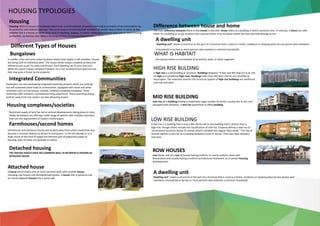
TYPES OF HOUSES.pptx
- 1. HOUSING TYPOLOGIES Housing Housing refers to houses or buildings collectively; accommodation of people; planning or provision of accommodation by an authority; and related meanings. The social issue is of ensuring that members of society have a home in which to live, whether this is a house, or some other kind of dwelling, lodging, or shelter. Many governments have one or more housing authorities, sometimes also called a housing ministry, or housing department Difference between house and home The main difference between them is that house is concrete. House refers to a building in which someone lives. In contrast, a home can refer either to a building or to any location that a person thinks of as the place where she lives and that belongs to her. A dwelling unit "Dwelling unit" means a structure or the part of a structure that is used as a home, residence or sleeping place by one person who maintains a household or by two or more persons who maintain a common household. Different Types of Houses Bungalows In smaller cities and semi-urban locations where land supply is still available, houses are being built on individual plots. The house owner enjoys complete privacy and infrastructure as per his taste and fervour. Such dwelling has its pros and cons. While the owner enjoys complete freedom, he is not insulated from external risks that may pose a threat to the property Housing complexes/societies Restricted supply of land has led to vertical developments taking place in cities. Today, developers are offering a wide range of options with multiple amenities that suit the requirement of modern home buyers. Integrated Communities Developers are also developing integrated township projects which are nothing but self-sustained urban hubs or communities. Equipped with social and other amenities such as club houses, schools, hospitals shopping complexes, these townships offer residents a wholesome living experience. These townships being built far away from city centers are also attracting buyers Farmhouses/second homes Farmhouses and vacations houses are located away from urban crowd have also become a common feature to attract hi-end buyers. In the last decade or so a large chunk of this kind of supply has become part of organised supply of housing, even as these are sporadic in nature. Attached house A house which shares one or more common walls with another house, including row houses and semidetached houses. A house that is joined to one (or more) adjacent house(s) by a party wall Detached housing THE HOUSES WHICH HAVE NO COMMON WALL IN BETWEEN IS KNOWN AS DETACHED HOUSE WHAT IS HABITAIT the natural home or environment of an animal, plant, or other organism HIGH RISE BULDING A high-rise is a tall building or structure ·Buildings between 75 feet and 491 feet (23 m to 150 m) high are considered high-rises. Buildings taller than 492 feet (150 m) are classified as skyscrapers. The materials used for the structural system of high-rise buildings are reinforced concrete and steel MID RISE BUILDING mid-rise (of a building) having a moderately large number of stories, usually five to ten, and equipped with elevators. a mid-rise apartment or office building. LOW RISE BUILDING A low-rise is a building that is only a few stories tall or any building that is shorter than a high-rise, though others include the classification of mid-rise. Emporia defines a low-rise as "an enclosed structure below 35 metres which is divided into regular floor levels." The city of Toronto defines a mid-rise as a building between 4 and 12 stories. They also have elevators and stairs ROW HOUSES row house. one of a row of houses having uniform, or nearly uniform, plans and fenestration and usually having a uniform architectural treatment, as in certain housing developments A dwelling unit Dwelling unit" means a structure or the part of a structure that is used as a home, residence or sleeping place by one person who maintains a household or by two or more persons who maintain a common household.